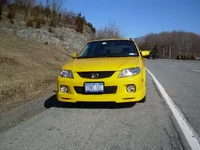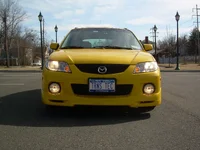Just for kicks I worked out some drag figures for the tires hitting the oncoming air. Picture a line drawn perpendicular to the road passing through the center of the axle. The tire has radius R and the car is moving at velocity V. Let the center of the axle be position zero, and let "x" measure the distance below (positive) or above (negative) the axle. The velocity at the axle is V, at the contact patch zero, and at the top of the tire 2V. Consequently along this line
V(x) = V( 1- x/R)
This is also the velocity at the leading edge of the tire at position x below the axle. (The horizontal component of the velocity of the tire for all points at "x", not just along the line we started with, is the same.)
The drag due to air hitting the tire is proportional to V(x) squared, so
V(x)^2 = V^2 * (1- x/R)^2
For a P5 with 195/50R16 tires the diameter calculated here
http://www.miata.net/garage/tirecalc.html
is 23.7 inches.
Here is a little table showing the factor (1- x/R)^2 for various
values of x in inches:
Code:
R-x x factor
0 11.85 0.000 (contact at the ground)
1 10.85 0.007
2 9.85 0.028
3 8.85 0.064
4 7.85 0.114
5 6.85 0.178
6 5.85 0.256
7 4.85 0.349
8 3.85 0.576
9 2.85 0.577
10 1.85 0.712
11 0.85 0.862
11.85 0.00 1.000 (at the axle)
23.7 11.85 2.000 (at the top of the tire)
As you would expect, there is not much to be gained by keeping the airflow off the bottom of the tire. A more interesting question becomes the Cd of the air diverter used. An air diverter attached to the body in front of the tire will be moving at velocity V. That's a faster velocity than any part of the tire currently exposed beneath the car. So for an air deflector in front of the tire to have any positive effect it must have a lower Cd than the tire cross section it covers. That suggests to me that a flat plate diverter (perpendicular to the flow, similar to the front air dam) would cause an increase in the overal Cd. A U shaped (low Cd) deflector a few inches tall might be useful though. Lowering the car two inches displaces the draggiest part of the exposed tires up into the body and so out of the airflow, and consequently lowers the overall Cd.


